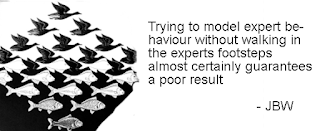DESIGN ITERATIONS ...
Don't model the behaviours of the expert - model the pathways they took to become that expert. Ideas and inventions bloom on the landscape, are taken up by early adopters, often improved upon, whereafter they are reborn, and on and on it goes. BJJ techniques also go through multiple design iterations as they are pressure-tested on the mat and evolve into the current versions of themselves that we all know and enjoy. What is not all that apparent though, is the fact that quite often, the original version of a technique becomes overlooked by the modern practitioner as he or she remains focussed only on the latest iteration of the idea with little or no knowledge of it’s ‘history/evolution’. Personally, I enjoy working through the history of a technique, from (what my coach refers to as ..) the ‘seed’ idea all the way through to the latest/greatest version. It is well worth re-tracing the evolutionary footsteps of a technique; in doing so, we:
- get a much deeper and more well-rounded understanding of it’s strengths and weaknesses
- may find that in many instances, the original/basic version of the technique is actually more practical and easy to apply. Techniques often become over-specialised after they are subjected to the evolutionary forces of the counter-counter-to counter ‘arms race’. (This process unfolds more quickly in a closed-environment)
- get to, albeit at an artificially accelerated rate, follow in the footsteps of the person who ‘developed’ the technique to a high level.
To conclude - I offer this - rather than modelling ‘current performance’ (of an expert, model the pathway that expert took to arrive at where he/she is today. Model the process not the outcomes … JBW
- get a much deeper and more well-rounded understanding of it’s strengths and weaknesses
- may find that in many instances, the original/basic version of the technique is actually more practical and easy to apply. Techniques often become over-specialised after they are subjected to the evolutionary forces of the counter-counter-to counter ‘arms race’. (This process unfolds more quickly in a closed-environment)
- get to, albeit at an artificially accelerated rate, follow in the footsteps of the person who ‘developed’ the technique to a high level.
To conclude - I offer this - rather than modelling ‘current performance’ (of an expert, model the pathway that expert took to arrive at where he/she is today. Model the process not the outcomes … JBW



Comments